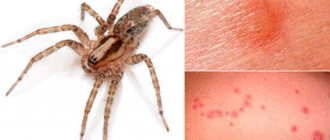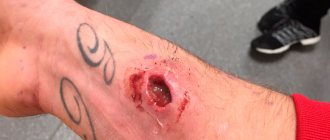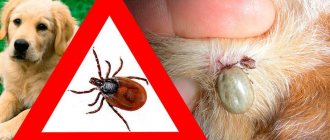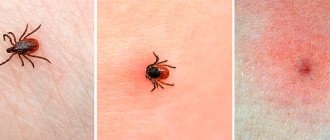Tick bites are not at all harmless to humans. The fact is that these arachnids are carriers of many dangerous infectious diseases. Among them are tick-borne encephalitis, borreliosis and many others. etc. Therefore, after a tick attack, it is imperative to understand whether the parasite is infected with any virus? How to find out about this? An excellent option is to take a blood test. It would also be a good idea to take the tick itself for examination to specialists. This is the only way to determine whether infection occurred after contact with a bloodsucker.
What to do if you are bitten by a tick?
Unfortunately, you have discovered a parasite attached to your body. What should be done in this case?
- First of all, don't panic. Calm down. Then remove the tick using one of the known methods.
- Treat the bite area. Iodine, alcohol, brilliant green solution, etc. are suitable.
- Do not throw away a tick (even a dead one)! Place it in a closed, airtight container (jar, bottle, medicine bottle, match box, etc.). The parasite will need to be sent to a special institution, where it will be determined whether it is a carrier of dangerous diseases.
- Take blood tests for borreliosis, tick-borne encephalitis, etc.
- See a doctor (preferably an infectious disease specialist or parasitologist) and undergo an examination, after which you may be prescribed medications. Their action will be aimed at quickly suppressing the infectious disease transmitted to humans by these arachnids.
- Monitor your health closely for 4 weeks after the tick bite. And even if the parasite was not infected. If the test of your blood or the tick itself is positive for viruses, then get ready for hospital treatment and long-term drug therapy.
It often happens that a person simply does not notice the parasite on his body. Only after a while does he discover the bite site and feel severe itching. Although the bloodsucker itself had already fallen off and crawled away. However, this does not reduce the risk of contracting a dangerous disease. Therefore, after such contact with a tick, you need to get tested.
Why get tested?
Ixodid ticks spread at least two socially significant pathologies. These are the well-known tick-borne encephalitis and Lyme disease (borreliosis). Diseases are by no means harmless, as they might seem at first glance. In some cases, infection of the body with Borrelia causes very severe long-term consequences. Signs of damage to the heart, joints, and nervous system develop. Only with a thorough investigation can they be linked to a history of Lyme disease. This is why it is recommended to take a blood test after a tick bite.
With late treatment, the percentage of transition to a chronic course can reach 50%. Timely laboratory testing and appropriate therapy ensure a favorable outcome of these and other serious bacterial diseases transmitted by ticks.
What tests should you take if you are bitten by a tick?
After a tick bite, you should not hesitate. Of course, the count is not in minutes or hours. But you shouldn’t delay contacting a medical institution (especially since many hospitals provide round-the-clock reception to those people who could potentially be infected with borreliosis, tick-borne encephalitis, etc.). The fact is that within the first five days symptoms of the disease may appear, and after 7-10 days (if the body is weakened) complications may begin.
It is important to remember that there is no point in taking a blood test immediately after an arthropod bite. This is explained by the fact that the result of such a study will be unreliable. After all, in the human body, as a response to the virus, specific antibodies (antiviral proteins-immunoglobulins) must be formed, which are detected by the analysis. And this takes time - up to 10 days, or even more. Therefore, many doctors recommend doing a blood test for tick-borne infections only 11-14 days after the bite.
In this situation, it is much more effective to bring the tick itself and submit it for examination. In this case, literally within the first day it will be possible to determine whether he was infected with some dangerous infection and whether there is a risk to human life and health.
As for the tests themselves, a wide range of laboratory tests are used to determine hidden infections after a tick bite. The specific diagnostic method is chosen by the doctor himself, taking into account:
- patient's age;
- the state of his immune system;
- whether vaccination was carried out;
- time that has passed since the bite;
- whether the person being examined took antibiotics and other medications.
- No earlier than 10 days after the bite, you can donate blood to detect tick-borne encephalitis and borreliosis using the PCR method. This is a fairly effective way to determine the presence of foreign DNA or RNA molecules in biomaterial: the tick itself, blood, skin biopath, urine, cerebrospinal and joint fluid. At the same time, PCR is also a rather complex method. Therefore, experts rarely give it preference.
- More common tests are ELISA (enzyme-linked immunosorbent assay) and Western blotting. They are aimed at identifying antibodies of the lgM and lgG classes, which begin to be actively produced in the human body 10 days after the bite of an infected tick. The research material in this case is venous blood. The advantages of both methods are high information content and accuracy.
- The most accessible and cheapest method is immunofluorescence analysis. It is used in most medical institutions (since a minimum of equipment and funds are required). It mainly examines blood serum, cerebrospinal fluid, and intra-articular fluid. In this case, during the analysis, specific antibodies are marked with a fluorescent dye, which makes them easy to see under a fluorescent microscope. In terms of accuracy, it is somewhat inferior to all of the above research methods.
The diagnostic result for most infectious diseases transmitted to humans through a tick bite is usually issued 3-5 days after blood collection. If it is positive, then after 2-4 weeks the test is repeated.
In some cities that do not have frequent cases of borreliosis or tick-borne encephalitis, it is impossible to donate blood after a tick bite for these infections. In this case, you may need to travel to a neighboring town or go to a private clinic. Sometimes specialists from the sanitary and epidemiological station (SES) can come to the rescue.
How long does it take to analyze the tick itself?
No less important is the examination of the bitten tick itself. As mentioned, it is not kept in the jar for more than 24 hours from the time it is removed. For microscopic examination it must be a living insect.
It’s a completely different matter with a PCR study of a tick - it’s good even dead, even just some part is enough and it will be good for 3 days. When a tick is delivered to the laboratory, it should be specifically instructed that it be examined simultaneously for all possible infections.
How much tick analysis is done depends on the laboratory and equipment. Most often, such an analysis is done within 3 days. In private clinics, it is possible to complete the study in 12 hours. You can store the tick at a temperature of strictly +5 degrees for two days.
How much does a test for tick-borne infections cost?
Can you hope that some institution will give you a free blood test for tick-borne encephalitis and other infections transmitted by the bite of this parasite? Hardly. Only if your health insurance includes this service.
What is the average cost of blood tests for tick-borne infections? Approximately 400-600 rubles in commercial organizations. At the same time, for this amount you will be tested for the presence of one type of viral pathogen - for example, encephalitis or borreliosis. Accordingly, the cost of a comprehensive study can cost 1000–2000 rubles. In government agencies, tariffs are usually lower by about 30-40%.
Ticks are also dangerous for pets. Especially for dogs, in which these parasites usually become embedded during walks in the forest or park. Therefore, if your pet feels unwell or you find a tick on its body, immediately contact a veterinary clinic and take a blood test for piroplasmosis. Indeed, without timely treatment, the mortality rate among dogs from this disease reaches 98%.
How many days after a bite should you donate blood?
To identify borreliosis, it is very important to monitor the dynamics of blood tests. The analysis is taken twice: the first time must be 10 days after the bite, and the second time 2-3 weeks after. Repeated analysis is necessary to determine the effectiveness of treatment. Laboratory detection of the borreliosis virus is carried out in the following cases:
- when there is a tick on the body, and even more so – several;
- when the bite took place in an epidemic zone;
- if it is discovered that the tick is a carrier of the virus;
- when the patient has symptoms of the disease;
- to differentiate one disease from others with similar symptoms (for example, meningitis);
- to determine how effective the prescribed treatment was;
- in order to confirm the diagnosis.
Blood is drawn from a vein in the morning on an empty stomach. It is advisable not to smoke for at least an hour before the test.
Returning to the question of what tests are taken for a tick bite, it is important to remember one thing: sometimes, although very rarely, borreliosis and encephalitis can develop simultaneously, so you need to take everything at the same time.
Populations of these insects live in any climate zone throughout Russia. This means that anyone can become a potential victim of this insect. Of course, the best option is timely vaccination against ticks. But, in any case, after being bitten, you should not panic, but strictly follow the instructions and get tested to detect diseases transmitted by ticks.
Where can I donate a tick?
Typically, the analysis of this type of disease spreader is carried out by specialized private and public institutions. They are available in most populated areas - cities, villages, urban-type settlements, etc. But in some areas there may not be such laboratories. So we recommend that you find out in advance which organization in your place of residence can submit a biting insect for further research.
Basically, the number of such institutions (where it makes sense to carry the tick) includes:
- SES;
- Private clinics;
- State medical institutions - emergency room, hospital, clinic, etc. Usually in such institutions there is a laboratory room that allows you to examine a tick to identify pathogens that it can transmit to humans.
If you have an infectious diseases hospital in your city, then the dangerous arthropod can be taken here. For example, to the same parasitology department, where they will analyze the tick for encephalitis and other diseases.
However, when you decide to take a tick for examination, do not forget to take money with you. The fact is that this service is mainly provided for a fee. How much do they charge to determine whether an arthropod is infected or not?
The cost of analyzing a tick for the presence of the causative agent of a particular disease in state medical institutions of the Russian Federation is approximately the same. As a rule, it is enough to pay 500-600 rubles to have an arthropod examined for borreliosis or encephalitis. In private medical centers and laboratories, testing a tick for the viruses it contains will cost approximately twice as much. For example, the popular network of laboratories in Russia today, Gemotest, estimates a comprehensive study of a tick at 2050 rubles, and it takes 2 days to complete. At the same time, in such establishments you can order an express analysis, which will be ready in a few hours.
Diseases
But a tick bite would not be terrible if ticks were not carriers of diseases. List of diseases that a tiny animal can give to a person (ticks are not insects):
- human monocytic ehrlichiosis;
- human granulocytic anaplasmosis;
- viral encephalitis;
- borreliosis;
- tularemia;
- Crimean hemorrhagic fever;
- relapsing tick-borne typhus;
- Tsutsugamushi fever;
- vesicular rickettsiosis;
- North Asian tick-borne rickettsiosis;
- Astrakhan spotted fever.
After contact with infectious ticks, people become infected with viral encephalitis and borreliosis.
How to store and properly transport a tick for analysis?
We have already clarified many important points. Although some questions still remain. They concern how to “handle” a tick – how to properly preserve it and what is the best way to move it?
- Firstly, after separating the arthropod from the bite site, it is recommended to immediately place it in the cold. Just not in the freezer! You cannot freeze the parasite! Optimal conditions for its storage and transportation are +2–8 °C. If it's hot outside, you can even add a piece of ice to the jar with this parasite.
- Secondly, if the tick has died, then in order to preserve the viruses, you need to put a cotton wool or cloth moistened with water in the container with the arthropod. Moisture will prevent bacteria from dying, which will increase the reliability of laboratory research.
- Thirdly, it happens that when a tick is pulled out of the wound at the site of the bite, the head or jaws of the parasite remain under the skin. Moreover, the bloodsucker itself is torn into pieces. What to do in such a situation? Is it possible to submit for analysis not a whole tick, but only a part of it? The answer is yes. Modern diagnostics make it possible to conduct a PCR study, even if the material used is only a fragment of the body of this small but dangerous animal.
- Fourthly, the tick must be submitted for analysis within two days. Longer periods lead to an increased risk of obtaining false positive or false negative results. In turn, this threatens with incorrect treatment or its absence. In both cases, this easily leads to serious complications and even death.
Rules for transporting ticks
It is best to remove the parasite from the body for research in a medical facility. This way you have a much better chance of avoiding infection. If you remove the insect yourself, you can seriously damage the body of an adult insect, and it will go even deeper under the skin. Also, the hospital will be able to immediately determine whether the parasite is dangerous.
If you managed to get the infectious insect yourself, it is recommended to take it to the laboratory. Rules for transporting ticks:
- After removal, the insect is placed in an environment with a temperature of 2°C to 8°C. It is best to place the beetle in the refrigerator before transporting it. The insect should not be frozen. If you put it in the freezer, the laboratory will not be able to test the parasite for the presence of the virus.
- The insect is carried in a jar. In hot weather, you can add an ice cube to it.
- After death, the tick dries out, and the bacteria quickly die. If he died, he must be kept in a container with liquid. A wet piece of cloth or soaked cotton wool will do. Bacteria will not die in a humid environment.
- The analysis is carried out in the first 48 hours after removing the tick. With a long period of time, the information content of the tests decreases and false results are possible.
If the beetle was extracted in parts, it can be submitted for research using the PCR method. A small piece of biological material is enough.











